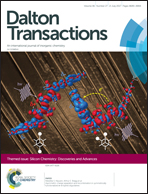(Oligo)aromatic species with one or two conjugated Si![[double bond, length as m-dash]](https://www.rsc.org/images/entities/char_e001.gif) Si bonds: near-IR emission of anthracenyl-bridged tetrasiladiene†‡
Si bonds: near-IR emission of anthracenyl-bridged tetrasiladiene†‡
Abstract
A series of aryl disilenes Tip2Si![[double bond, length as m-dash]](https://www.rsc.org/images/entities/char_e001.gif) Si(Tip)Ar (2a–c) and para-arylene bridged tetrasiladienes, Tip2Si
Si(Tip)Ar (2a–c) and para-arylene bridged tetrasiladienes, Tip2Si![[double bond, length as m-dash]](https://www.rsc.org/images/entities/char_e001.gif) Si(Tip)–LU–Si(Tip)
Si(Tip)–LU–Si(Tip)![[double bond, length as m-dash]](https://www.rsc.org/images/entities/char_e001.gif) SiTip2 (3a–d) are synthesized by the transfer of the Tip2Si
SiTip2 (3a–d) are synthesized by the transfer of the Tip2Si![[double bond, length as m-dash]](https://www.rsc.org/images/entities/char_e001.gif) SiTip unit to aryl halides and dihalides by nucleophilic disilenides Tip2Si
SiTip unit to aryl halides and dihalides by nucleophilic disilenides Tip2Si![[double bond, length as m-dash]](https://www.rsc.org/images/entities/char_e001.gif) SiTipLi (Tip = 2,4,6-iPr3C6H2, Ar = aryl substituent, LU = para-arylene linking unit). The scope of the nucleophilic Si
SiTipLi (Tip = 2,4,6-iPr3C6H2, Ar = aryl substituent, LU = para-arylene linking unit). The scope of the nucleophilic Si![[double bond, length as m-dash]](https://www.rsc.org/images/entities/char_e001.gif) Si transfer reaction is demonstrated to also include substrates of considerable steric bulk such as mesityl or duryl halides Ar–X (Ar = Mes = 2,4,6-Me3C6H2; Ar = Dur = 2,3,5,6-Me4C6H, X = Br or I). Bridged tetrasiladienes Tip2Si
Si transfer reaction is demonstrated to also include substrates of considerable steric bulk such as mesityl or duryl halides Ar–X (Ar = Mes = 2,4,6-Me3C6H2; Ar = Dur = 2,3,5,6-Me4C6H, X = Br or I). Bridged tetrasiladienes Tip2Si![[double bond, length as m-dash]](https://www.rsc.org/images/entities/char_e001.gif) Si(Tip)–LU–Si(Tip)
Si(Tip)–LU–Si(Tip)![[double bond, length as m-dash]](https://www.rsc.org/images/entities/char_e001.gif) SiTip2 with more extended linking units surprisingly exhibit fluorescence at room temperature, albeit weak. DFT calculations suggest that partial charge transfer character of the excited state is a possible explanation.
SiTip2 with more extended linking units surprisingly exhibit fluorescence at room temperature, albeit weak. DFT calculations suggest that partial charge transfer character of the excited state is a possible explanation.
![Graphical abstract: (Oligo)aromatic species with one or two conjugated Si [[double bond, length as m-dash]] Si bonds: near-IR emission of anthracenyl-bridged tetrasiladiene](/en/Image/Get?imageInfo.ImageType=GA&imageInfo.ImageIdentifier.ManuscriptID=C7DT00397H&imageInfo.ImageIdentifier.Year=2017)
- This article is part of the themed collection: Silicon Chemistry: Discoveries and Advances


 Please wait while we load your content...
Please wait while we load your content...
![[double bond, length as m-dash]](https://www.rsc.org/images/entities/h2_char_e001.gif) Si bonds: near-IR emission of anthracenyl-bridged tetrasiladiene
Si bonds: near-IR emission of anthracenyl-bridged tetrasiladiene